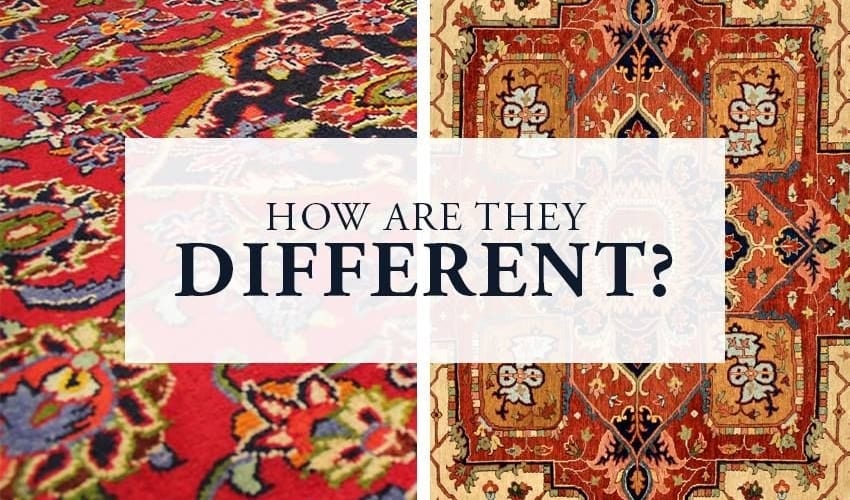
At Steve’s Carpet Care we offer the best Persian and Oriental rug cleaning in Longmont, Boulder and more Colorado communities. We have many years’ experience in the care and cleaning of these precious heirloom rugs and devote a lot of time and energy into ensuring their integrity and longevity. During the course of our business we often encounter owners unsure whether they have a Persian rug or an Oriental rug. If the rug was bought new or from an auction house there should be no doubt about it provenance. However, some folks purchased their rugs from private sellers or they inherited their rugs from relatives. In either case the exact nature and origins of the rug are unknown to them because the rug has no tag. Or maybe an aftermarket tag has been affixed to the rug by a reseller. So how can you tell for sure which type of rug you have?
Telling the Difference Between Oriental and Persian Rugs
We often encounter customers unsure of what type of rug they have. Or they wish to buy a Persian or Oriental rug but don’t know how to tell them apart if they don’t have a tag on them. The confusion is easy to understand because the terms ‘Oriental’ and ‘Persian’ are often used interchangeably, even by people who should know better. So let’s look at the ways you can tell the two apart.
- Country of Origin - There is legitimate confusion caused by how you define the word ‘Orient’. Over the centuries a laundry list of countries have been referred to as Oriental countries. This includes China, Nepal, Tibet, Pakistan, Russia, Afghanistan, India and Iran. So where does the confusion come from? Well, the last entry on that list - Iran - used to go by the name ‘Persia’. In addition, parts of some of those other countries were once part of Persia. The bottom line on country of origin is this: if it was made in the past half century and it says “Made in Iran” it’s a Persian rug. If says any other country it’s an Oriental. In the course of our Persian rug cleaning activities though, we see plenty of old rugs that have no labels. These require other methods of identification.
- Type of Knots - Both genuine Persian and genuine Oriental rugs are known for their incredible level of craftsmanship. Both are hand-knotted using centuries-old techniques. And either may have up to 160 hand-tied knots per square inch. Which is pretty amazing when you think of it. Those knots however can be very helpful in determining where the rug came from and whether it’s an Oriental or a Persian. Genuine Persian rugs are created using the asymmetrical Senneh knot. And while some rug makers in neighboring countries still use the Senneh knot most use the symmetrical Ghiordes knot. So while knots are a good way to distinguish one type of rug from the other there is still some room for confusion. Especially with older rugs.
- The Design - If you’ve come close to nailing down the origins of your rug using the knot system but are still uncertain, take a good look at the design. Persian rugs tend to exhibit more geometric patterning than Oriental rugs. Persian rugs, in fact, typically employ either a central medallion design, a compartmentalized design, a one-sided design or an all-over design. The colors are also typically limited to earthen hues like rust, ivory, red, sage and indigo. Oriental rugs on the other hand use a wider array of patterns. They may employ landscape motifs or images of flowers and wildlife. And the design in general is typically more curvilinear than a Persian design. In addition, Oriental rugs are not usually as limited in their color palette as a Persian rug will be. So it’s not unusual to see complementary colors in an Oriental rug. Or brighter, almost primary colors in some places. So…
- Persian rugs - Subdued colors, geometric patterns, asymmetrical Senneh knots
- Oriental rugs - Slightly brighter colors and more of them, curvier patterns with flowers, animals and such, as well as symmetrical Ghiordes knots
In some cases, particularly with very old rugs, the distinctions between Persian and Oriental may be tougher to discern. In that case you should have the rugs appraised by an expert. They’ll be able to determine its exact origins and value.
Why You Should Use Steve’s Persian and Oriental Rug Cleaning Service
Regardless of whether your rug is Persian or Oriental it needs to be cleaned in the same painstaking way to ensure its continued value and integrity. At Steve’s we have decades of rug cleaning experience and are Colorado’s most trusted Persian and Oriental rug cleaning service. Our process is based on centuries’ old tried and true techniques and will never cause carpet damage in any way. Here are the steps we take when cleaning this type of rug:
- Thorough inspection of the rug and assessment of its overall condition
- Initial spot treatment of food, drink or pet stains (if necessary)
- Professional hand-washing of the carpet
- Thorough rinsing before the rug is hung to dry
- Once dry the carpet is then carefully groomed to restore loft
- A final inspection is undertaken to look for any details that might have been missed
- If touchups are necessary they are completed and the rug returned to you
If you need Oriental or Persian rug cleaning trust the pros at Steve’s Carpet Care. We’ll restore the luster and life of your rug for less than you imagine.
